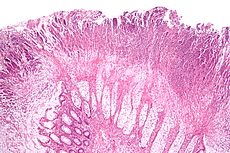Ischemic colitis pathophysiology: Difference between revisions
Hamid Qazi (talk | contribs) No edit summary |
Hamid Qazi (talk | contribs) No edit summary |
||
| Line 44: | Line 44: | ||
==References== | ==References== | ||
{{Reflist|2}} | {{Reflist|2}} | ||
{{WH}} | {{WH}} | ||
| Line 50: | Line 49: | ||
[[Category:Gastroenterology]] | [[Category:Gastroenterology]] | ||
[[Category:Surgery]] | [[Category:Surgery]] | ||
[[Category:Disease]] | [[Category:Disease]] | ||
[[Category:Cardiology]] | [[Category:Cardiology]] | ||
[[Category:Emergency medicine]] | [[Category:Emergency medicine]] | ||
[[Category:Up-To-Date]] | |||
Revision as of 13:10, 10 January 2018
|
Ischemic colitis Microchapters |
|
Case Studies |
|
Ischemic colitis pathophysiology On the Web |
|
American Roentgen Ray Society Images of Ischemic colitis pathophysiology |
|
Risk calculators and risk factors for Ischemic colitis pathophysiology |
Editor-In-Chief: C. Michael Gibson, M.S., M.D. [1]; Associate Editor(s)-In-Chief: Hamid Qazi, MD, BSc [2]
Overview
Ischemic colitis is the result of a sudden, temporary, reduction in blood flow that is insufficient to meet the metabolic demands of the region of colon. Ischemic change will subsequently extend from the mucosa to the serosa. Mucosal injury will develop in 20 minutes to 1 hour, and transmural infarction occurs within 8 to 16 hours. Reperfusion injury can occur with the release of reactive oxygen species, which cause lipid peroxidation within cell membranes, causing cell necrosis.
Pathophysiology
The pathophysiology of ischemic colitis is as follows:[1][2][3][4]
Colonic Blood Supply
- Colon receives blood from the superior and inferior mesenteric arteries.
- Blood supply from these arteries overlap, with abundant collateral circulation.
- There are weak points, or "watershed" areas, at the borders of the territory supplied by each of these arteries.
- Rectum receives blood from the inferior mesenteric artery and the internal iliac artery
Development of Ischemia
- Colon receives between 10% and 35% of the total cardiac output.
- If blood flow to the colon drops by more than about 50%, ischemia will develop.
- The arteries feeding the colon are very sensitive to vasoconstrictors
- During periods of low blood pressure, the arteries feeding the colon clamp down vigorously.
- Vasoconstricting drugs such as ergotamine, cocaine, or vasopressors can also cause colonic ischemia..
- Result in non-occlusive ischemic colitis.
Microscopic Pathology
- A range of pathologic findings are seen in ischemic colitis, corresponding to the spectrum of clinical severity.
- Mildest form, mucosal and submucosal hemorrhage and edema are seen, possibly with mild necrosis or ulceration.
- With more severe ischemia, a pathologic picture resembling inflammatory bowel disease (i.e. chronic ulcerations, crypt abscesses and pseudopolyps) may be seen.
- In the most severe cases, transmural infarction with resulting perforation may be seen.
- After recovery, the muscularis propria may be replaced by fibrous tissue, resulting in a stricture.
- Following restoration of normal blood flow, reperfusion injury may contribute to the damage to the colon.
Images

Micrograph of a colonic pseudomembrane, a finding that may be associated with ischemic colitis. H&E stain.
Videos
{{#ev:youtube|LCwMQU7ylYg}}
References
- ↑ Rosenblum JD, Boyle CM, Schwartz LB (1997). "The mesenteric circulation. Anatomy and physiology". Surg Clin North Am. 77 (2): 289–306. PMID 9146713.
- ↑ Granger DN, Rutili G, McCord JM (1981). "Superoxide radicals in feline intestinal ischemia". Gastroenterology. 81 (1): 22–9. PMID 6263743.
- ↑ Brandt LJ, Boley SJ, Goldberg L, et al: Colitis in the elderly. Am J Gastroenterol 76:239, 1981.
- ↑ Washington, Christopher; Carmichael, Joseph (2012). "Management of Ischemic Colitis". Clinics in Colon and Rectal Surgery. 25 (04): 228–235. doi:10.1055/s-0032-1329534. ISSN 1531-0043.